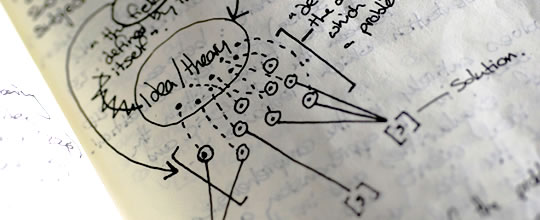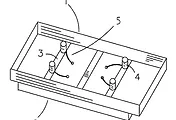1. 조건 가정적으로 사고하라!
조건을 가정하여 무엇이 일어나게 될 것인지를 상정하는 사고방식이 창의력을 향상에 큰 효력이 있다.
연구에 따르면 이 방법에 의해 사람들의 창의력이 두배 이상 높아질 수 있다고 한다. 하지만 해결하고자 하는 문제에 적합한 방식으로 조건 설정을 하여야만 제대로 효력이 있다고..
분석적 과제인 경우에는 뺄셈식 사고 기법이 바람직하고,
확장형 과제의 경우에는 덧셈식 사고기법이 최적이다.
뺄셈식은 그 상황에서 무엇을 제거할 것인지를 생각하고, 덧셈식은 그 상황에 무엇을 더할 것인지를 생각한다.
2. 두개의 문제가 하나의 문제보다 더 유리하다.
사람들은 대개의 문제를 아날로그(유추)적으로 푼다. 즉 유사한 옛날 일을 상기하여 동일 내지 유사한 솔루션을 적용한다. 그런데 연구결과에 따르면 사람들은 자신이 이미 풀었던 과거의 비슷한 문제를 잘 기억해내지 못한다고 한다.
연구에 따르면 하나의 문제 보다는 두개의 문제를 한꺼번에 풀면 과거에 풀었던 문제를 더욱 잘 기억해낸다고 한다.
그래서 복잡한 문제를 회피하지 말고 오히려 모두 끌어모아라. 그 문제들이 기억을 흘들어 깨우는 데 도움이 된다.
3. 총괄적 개념의 동사를 사용하라!
아날로그(유추)적 사고를 활성화시키는 방법 중에는 문제를 써나가는 방법이 있다. 그렇게 써놓고 나서는 그 문제에 특정적인 동사를 찾아내어 그것을 좀더 총괄적인 개념의 동사로 바꾼다.
이 방법에 의하면 일부 과제에서 성과가 100% 이상 향상되었다는 연구결과가 있다.
특정의 구체적인 부분에 집착하지 말고 문제의 상위개념에 집중하라!
4. 동의어와 카테고리 분류를 활용하라!
동사 변경과 마찬가지로, 동의어와 카테고리 분류를 이용하여 문제를 재구성하는 것도 효과적이다.
이 기법은 해당 문제의 종류를 분석하고 다른 방식으로 표현하는 것을 의미하며, 문제의 하부구조에 접근하여 해결책을 찾아내는 데 중요한 기여를 한다.
5. 싸우고, 싸우고, 싸워라!
논쟁을 할 때 사람들이 더 소심해지고 경직되어 결국 창의성이 저하된다고 생각하는 경향이 있다.
그러나 연구에 따르면 실제로는 그 반대이다. 의견출돌이 있을 때 사람들은 그 문제에 더 많이 관계하게 되고 논쟁 방법을 더 많이 창출하게 된다는 것이다.
사회적 의견충돌 상황에서는 사람들이 사안에 집중하도록 강한 동기부여를 받게 된다.
그래서 창의적으로 되려면 우선 싸우기부터 하라!
6. 사랑을 하라!
섹스는 아니고..
실험자들에게 사랑을 생각하게 하였을 때 사람들이 더욱 창의적으로 된다는 연구결과가 있다. 그러나 성적 욕구를 느끼게 했을 때는, 더 분석적으로 되기는 하였지만, 창의력은 저하하였다.
사랑은 사람의 사고가 길고 멀리 보도록 하여 더욱 추상적이고 더욱 유추적으로 사유하게 한다.
그러나 섹스는 지금 현재를 의미하며 구체적이면서 분석적인 처리 스타일이 되게 만든다.
창의적이기 위해서는 추상적, 유추적 사고가 바람직하다.
7. 헛된 꿈을 꾸지 말라!
아이디어를 키우기 위해서는 공상이 도움이 된다고 들어왔다.
그러나 연구에 따르면 아이디어 인큐베이팅이나 무의식적인 사고 과정은 거의 도움이 되지 않는다고 한다. 무의식적 창의성은 그저 무의식에 남아있을 뿐이다.
그리고 아이디어 인큐베이팅도 무의식이 인큐베이팅하기에 충분한 정보들을 가지고 있을 경우에만 의미가 있을 뿐이다.
그래서 공상은 집어치우고, 실행에 옮겨라!
출처 :
http://www.spring.org.uk/2010/06/get-creative-7-more-psychological-techniques.php
Get Creative: 7 More Psychological Techniques

"Creativity can solve almost any problem. The creative act, the defeat of habit by originality overcomes everything." ~George Lois
Following on from a previous article on how to be creative, which had a tremendous response, here are another 7 techniques for breaking through a creative block.
1. Counterfactual mindset
Conjuring up what might have been gives a powerful boost to creativity.
Markman et al. (2007) found that using counterfactuals (what might have happened but didn't) sometimes doubled people's creativity. But counterfactuals work best if they are tailored to the target problem:
- Analytical problems are best tackled with a subtractive mind-set: thinking about what could have been taken away from the situation.
- Expansive problems benefited most from an additive counterfactual mind-set: thinking about what could have been added to the situation.
2. Two problems are better than one
People solve many problems analogically: by recalling a similar old one and applying the same, or similar solution. Unfortunately studies have found that people are poor at recalling similar problems they've already solved.
In a counter-intuitive study, however, Kurtz and Lowenstein (2007) found that having two problems rather than one made it more likely that participants would recall problems they'd solved before, which helped them solve the current problem.
So don't avoid complications, gather them all up; they may well help jog your memory.
3. Generic verbs
Another boost for analogical thinking can be had from writing down the problem, then changing the problem-specific verbs to more generic ones.
What Clement et al. (1994) discovered when they tested this method was that analogical leaps are easier when problems were described in looser, more generic terms. In this study performance increased by more than 100% in some tasks.
This is just one of a number of techniques which encourage focus on the gist of the problem rather than its specific details.
4. Synonyms and category taxonomies
Just like changing the verbs, re-encoding the problem using synonyms and category taxonomies can help.
This means analysing the type of problem and coming up with different ways of representing it. Lowenstein (2009; PDF) emphasises the importance of accessing the underlying structure of the problem in order to work out a solution.
5. Fight! Fight! Fight!
We tend to think that when people are arguing, they become more narrow-minded and rigid and consequently less creative.
But, according to research by Dreu and Nijstad (2008), the reverse may actually be true. Across four experiments they found that when in conflict people engaged more with a problem and generated more original ways of arguing.
Being in social conflict seems to give people an intense motivated focus. So, to get creative, start a fight.
6. Think love not sex
Forster et al. (2009) found that when experimental participants were primed with thoughts of love they became more creative, but when primed with carnal desire they became less creative (although more analytical).
While it certainly isn't the first time that love has been identified as a creative stimulus, psychologists have suggested a particular cognitive mechanism.
Love cues us with thoughts of the long-term, hence our minds zoom out and we reason more abstractly and analogically. Sex meanwhile cues the present, leading to a concrete analytical processing style. For creativity, abstraction and analogy are preferred.
7. Stop daydreaming
To increase creativity we're always hearing about the benefits of daydreaming for incubating ideas. It's a nice idea that all the work is going on under the hood with no effort from us. But you'll notice that all the methods covered here are active rather than passive.
That's because the research generally finds only very small benefits for periods of incubation or unconscious thought (Zhong et al., 2009). The problem with unconscious creativity is that it tends to remain unconscious, so we never find out about it, even if it exists.
The benefit of incubating or waiting may only be that it gives us time to forget all our initial bad ideas, to make way for better ones. Moreover, incubating only works if the unconscious already has lots of information to incubate, in other words if you've already done a lot of work on the problem.
So: stop daydreaming and start doing!
Move abroad and learn another language
If all that fails, including the 7 techniques from the previous article, then I've got one radical, bonus suggestion: move to another country and learn another language. Maddux and Galinsky (2009) found that people who had lived abroad performed better on a range of creative tasks.
In an experimental test of this idea, Maddux et al. (2010) asked participants to recall multicultural learning experiences and found that this made people more flexible in their thinking and better able to make creative connections.
This only worked when people had actually lived abroad, not when they just imagined it.
'경영과 세상살이 > 창의력' 카테고리의 다른 글
| [굿아이디어] 열쇠고리 (1) | 2012.02.22 |
|---|---|
| [굿아이디어] 유람선에 설치된 자동 수평 유지 당구대 (1) | 2012.02.15 |
| 창의력을 높여주는 7가지 색다른 심리학적 기법 (0) | 2012.02.11 |
| "밥솥은 과학이 아닙니다. 관록입니다." (1) | 2012.01.18 |
| [굿아이디어] 삼성전자가 제시한 미래의 디스플레이 창문 (0) | 2012.01.12 |

